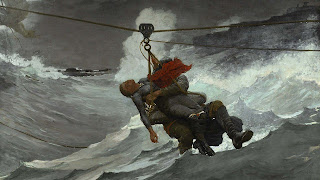In our current “War on Terror,” it’s sometimes hard to imagine or appreciate the terrors of times gone by. For Americans of the 19th century, stories of shipwrecks struck deep into their souls. Many harbored fresh memories of a harrowing crossing to the New World from Europe. Tales of rescue efforts that were too little, too late, or both filled newspapers and raised public ire. In the response to this uproar, the U.S. Government legislated in 1878 the development of a network of coastal life-saving stations called the Live-Saving Service. Six years later, Winslow Homer painted The Life Line, a celebration of these rescuing heroes that made Homer famous almost overnight and that still captures viewers’ imaginations today. Shipwreck! Winslow Homer and “The Life Line”, which runs at the Philadelphia Museum of Art through December 16, 2012, rescues the importance of this stirring picture not just as a great artistic achievement but also as a snapshot of a moment in time when heroes won their war on the terror of the seas. Please come over to Picture This at Big Think to read more of "Rescuing the Importance of Winslow Homer’s Life Line."
[Image: Winslow Homer,
American, 1836-1910. The
Life Line, 1884. Oil on canvas, 28 5/8 x
44 3/4 inches (72.7 x 113.7 cm). Philadelphia Museum of Art, The George W.
Elkins Collection, 1924.]
[Many thanks to the Philadelphia Museum of Art for the image above, an invitation to the press release for, and press materials related to Shipwreck! Winslow Homer and “The Life Line”, which runs through December 16, 2012.]



No comments:
Post a Comment